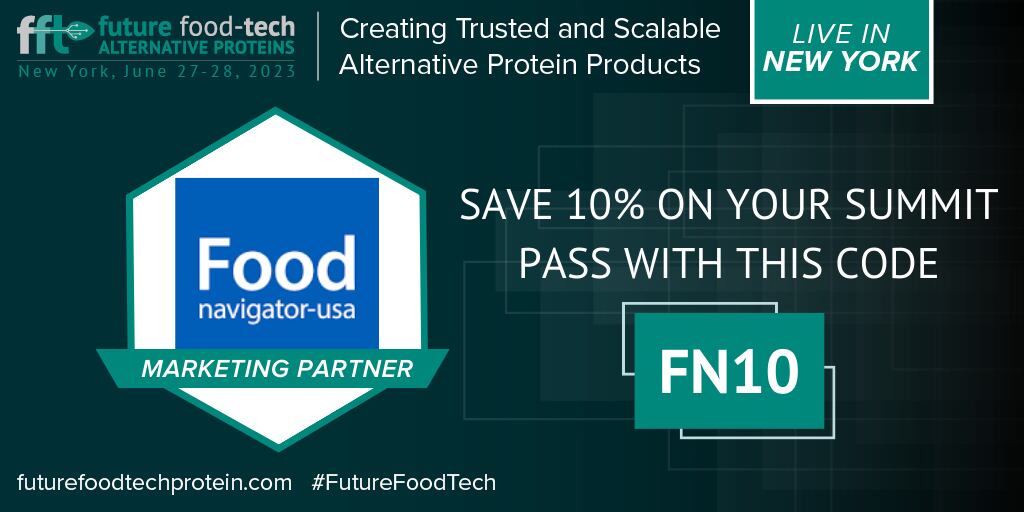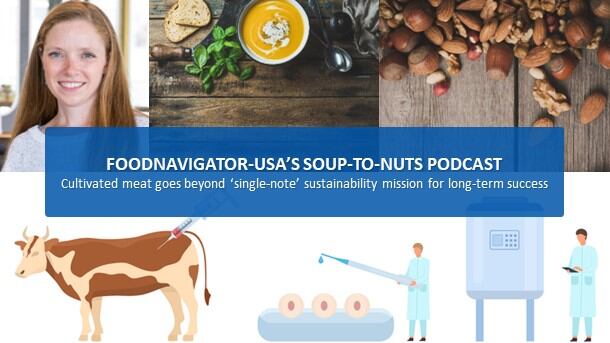A new report from the life sciences, food and beverage consultancy CRB found in the past two years the cultivated meat industry has grown exponentially with new players entering the space with new business strategies – and in doing so they have attracted significant investments, lowered production costs to inch closer to price parity for select items and helped drive up consumer interest.
But, as CRB alternative proteins sub market leader Sebastian Bohn notes in this episode of FoodNavigator-USA's Soup-To-Nuts podcast, the timeline for getting cultivated meat into the hands of mainstream Americans via retail could be upwards of six or seven years with more limited availability in the next three to five years at restaurants. This is a best-case scenario though, and getting there will require strategic partnerships to efficiently scale production, increased investment across the supply chain to lower input costs and enhanced contract manufacturing that frees up resources and bandwidth for others to develop additional cell lines and media formulation. Because each of these components will move forward at different speeds for different players, Bohn expects to see a shake out – but who will survive and who will fall remains anyone's guess.
[Editor’s note: Never miss an episode of FoodNavigator-USA’s Soup-To-Nuts podcast – subscribe today.]
Cultivated meat’s meteoric growth stems from established tech, shared values
While the cellular meat industry is still in its early days, Bohn says the segment is growing fast thanks to a foundation of established technology, sustained government and investor interest and a raft of benefits that resonate with consumers and businesses alike.
“One of the neat thinks about this industry is it is so new, but the technology itself isn’t. So, when you’re talking about the basis for how all of these processes are starting, that culture operation has been in the life sciences industries for decades. The new aspect to this and why there’s, I think, this lower barrier of entry from a technology standpoint at least to get started is because of that technology having been around. But now it’s how to apply it to the food process,” Bohn said.
While he acknowledged that cellular agriculture is not a trend that consumers might easily buy into initially, he believes the space will continue to grow exponentially because it offers so many benefits.
For example, Bohn called out the climate benefits of cultivated meat compared to traditional animal agriculture, the potential for more local production and the ability to make products that consumers actually want and will meet their taste, texture and functional requirements.
After clearing initial hurdles, more challenges remain ahead
Despite the benefits of and buzz surrounding cultivated meat created FDA’s tacit approval of two companies’ products in less than a year and viral publicity stunts like the Mammoth meatball created by Australian startup Vow, the industry has a lot of challenges to overcome before it can seize its full potential.
Bohn explains that many companies are still in the proof-of-concept stage with only benchtop or pilot scale production and nearly all are grappling with high costs of limited inputs – both of which can only be addressed with increased investments elsewhere in the supply chain and in adjacent downstream manufacturing.
For example, he argues, the industry needs to invest in equipment and inputs to support cellular growth as both are currently limited and, therefore, expensive.
“There’s been a lot of investment just into the companies themselves making the product. So, I think, [Good Food Institute’s] recent report was to date over $2bn, and we’re talking almost a billion year-over-year since 2020. … But a lot of that investment is specifically just in those enablers of the cultivated meat – so the ones manufacturing the products. There has not been as much investment, or event startup themselves looking at the supply chain,” he said.
He argues that developing growth media, feed, growth factors and other components will require partnerships – with private and public entities.
A ten-year timeline
With so many moving components and logistics to navigate, Bohn says a realistic timeframe for cultivated meat hitting mainstream retail is in about ten years. Although, he added, that point my consumers will be comfortable buying and consuming cultivated meat because manufacturers will have rolled out their products through restaurants and in more limited offerings while they scale their production.
“What we’ll end up seeing is more of a phased rollout,” he said.
He explained that most stakeholders think they will have FDA and USDA approval within two years, but at that point manufacturing capacity will still be limited – resulting in just enough product for select restaurants and limited distribution.
“The average duration to build a new facility or even retrofit a facility where you need to have significant production of any food product is likely in the ballpark of 12 to 16 months – especially with some of the supply chain issues of construction, materials and equipment that is required of these processes,” he said.
Is a shakeout on the horizon?
As the cultivate meat industry continues to evolve and some players clear regulatory, production and consumer perception hurdles more quickly than others, Bohn warns there will be a shaking out – as there has been across all cutting edge industries as they mature.
“My assumption is we will see a shakeout now. I think what we’ll end up seeing is you’ll have your handful that actually become the partnerships with the big companies … and you’ll have a few that may … have bit off more than they can chew and invested too much capital upfront” and will faulter, he said.
As time goes on and the first wave of companies gain their approval, there will likely be some consolidation based on early consumer feedback, he added.
According to Bohn, the companies that survive this shakeout will be the ones that put the consumer first. While this idea that may sound obvious, it wasn’t a foundational value in the cultivated meat space – or the plant-based protein segment for that matter – which means winners likely will need to shift their mindset and priorities for long-term success.
As production and consumer adoption increase in the next ten years, Bohn says there will be more wiggle room for companies to get more creative and offer products that consumers might not need – or even imagine – but which they will be more open to as they become more familiar with the basic value proposition of cultivated meat.
CRB goes into more detail about how the cultivated meat industry is maturing and what to expect in the next decade in its 2023 Alternative Proteins report, which listeners can download at https://go.crbgroup.com/horizons-alternative-proteins-2023. The report also takes a deep dive not fermentation-derived proteins, plant- and mycelium-based meat and alternative dairy products and productions.
Those who are interested in alternative proteins can also get a crash course in all aspects of the industry – including taste testing – at future food-tech’s alternative proteins two-day conference in New York City later this month. Find all the details and register at https://download.futurefoodtechnyc.com/FNU. With FoodNavigator-USA’s discount code – FN10 – you can save 10%.





